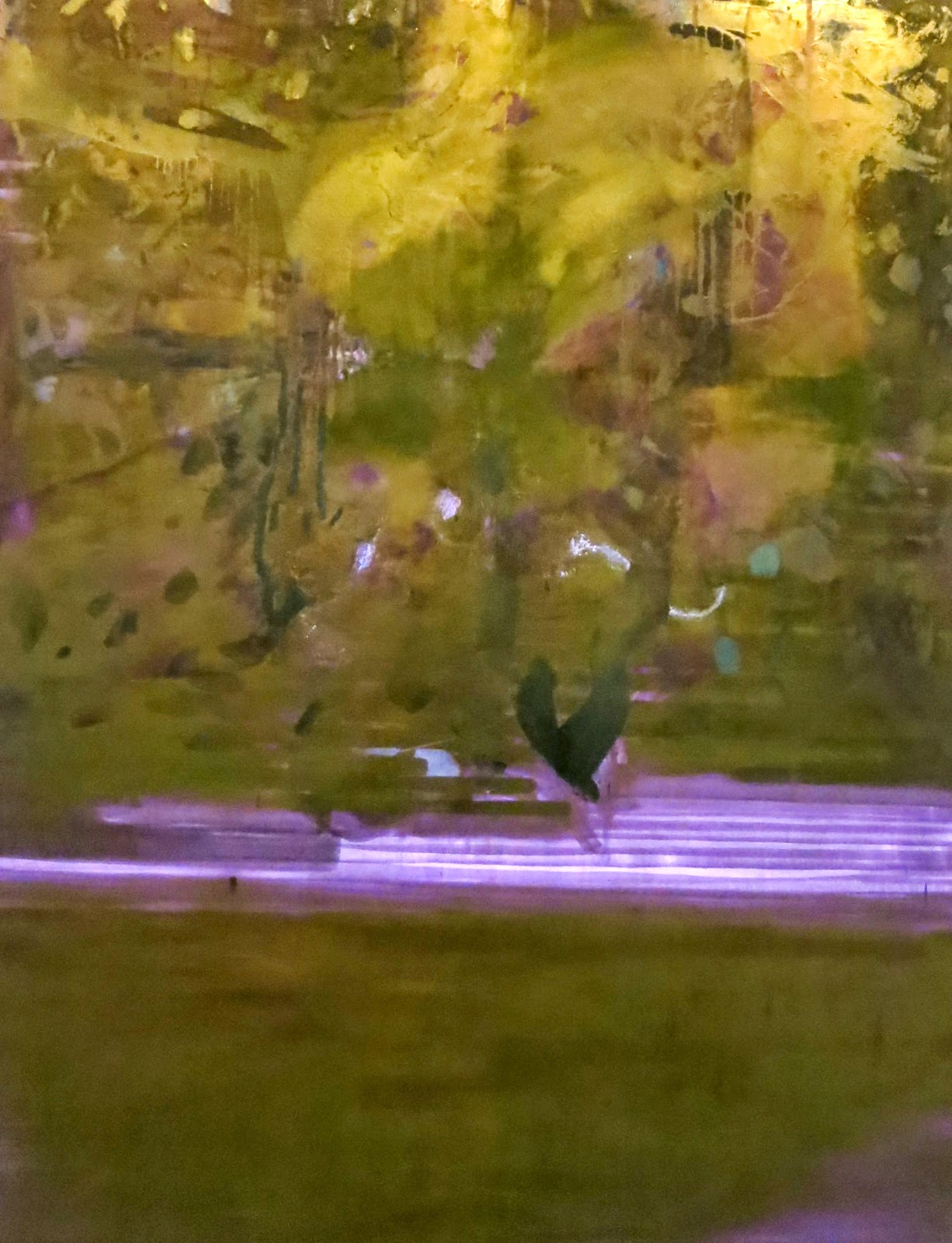Alibis: Sigmar Polke at Tate Modern.
I did not 'get' Polke. Or maybe I should start at the beginning and the beginning for me when I see a work of art or go to an exhibition is first of all the emotional response: do I like it? Do I respond to it either emotionally or intellectually? Does it move me? I try not to read about an artist or the work until after I have seen and responded. With this exhibition I did not want to read or find out. I could not be bothered as I felt absolutely nothing when I saw the work except a feeling of being overwhelmed: it's all too busy, too chaotic, and in the end, for me, too tiresome.
This is how the review in the Telegraph finished: 'When the viewer doesn't have a handle on the moral or cultural context that made the image important to [him], we switch off. In the end, it's best not to over think this work and just enjoy the show as giant, constantly shifting kaleidoscope of photos, films and paintings, very much in the spirit of the 1960s'.
I am/was a child of the 1960s but this show did not 'do' it for me. There was no enjoyment, let alone any understanding. I switched off.
I did nevertheless take some photographs which I will post here as a reminder of what I saw.
Raster Drawing (Portrait of Lee Harvey Oswald), 1963
Polke looked closely at pictures in newspapers and magazines that were printed as 'raster' images made up of rows of dots. When these were blown up, the individual dots became more prominent and the image began to disintegrate. Polke painted the dots freehand at first, and then began to use punctured screens.
Untitled, 1963
(Do these remind you of another artist's work? These were painted in 1963, and they were painted by hand, rather in a factory 'by numbers')
The Ride on the 8th of Infinity III, 1969-71
Alice in Wonderland, 1972
During the 1970s Polke moved to a farmhouse in the countryside. Surrounded by friends they experimented with hallucinogenic drugs which led to new viewpoints and images.
Untitled, 1972
Against the Two Superpowers - for a Radical Switzerland, 1976
Lump of Gold, 1982
Negative Value II, 1982
In this painting Polke used pigments that would change from purple to bronze when burnished. The canvas appears very different depending on the viewing angle and light conditions.
Scissors, 1982
The source for this painting is an image of the early 20th century Polish medium Stalinislawa Tomczyk apparently levitating a pair of scissors.
Fear, Black Man
Here Polke combined images of a crowd with upheld arms and a shadowy protagonist appearing to be about to launch himself in a jump, creating a scene that has been likened to prints by Francisco de Goya showing grotesque giant figures towering over terrified gatherings.
Printing Error, 1986
Watchtower
Between 1984 and 1988 Polke made several Watchtower paintings, keeping the meaning deliberately ambiguous. Watchtowers like these are found throughout the German countryside and are used by hunters shooting game; they are also reminiscent of the towers on the periphery of Nazi concentration camps. Equally they are associated with the Berlin Wall and the border then dividing East and West Germany.














Eirene, I must agree: I am moved enough by Polke's work to turn away from it, seeking something more interesting. On a personal level the dots irritated me in a 'so what' way I suppose because I spent so long in publishing with the dot screen as part of the basics of reproduction. Besides, Lichtenstein had done it much better - although he too is not amongst my top favourite artists.
ReplyDeleteThe only work which might tease my interest is that with watchtowers, but like so much of his stuff, there is no subtlety of thought or expression there for me. I knew that this show was on at the same time as the Kiefer, and it was a no brainer which I would see.
I did not know anything about him, Olga, but I read somewhere (I wish I could remember where) that the three contemporary German greats are Richter, Kiefer and Polke. Being a great fan of the first two, I thought that I must not miss this exhibition. We went to London to see the Malevich and after a long and leisurely lunch, went into the other galleries.... Oh well!
DeleteI agree about Lichtenstein on both counts.
Other contemporary German artists whose work I rate highly are:
DeleteBernd and Hilla Becher
http://www.tate.org.uk/art/artists/bernd-becher-and-hilla-becher-718
http://www.theguardian.com/artanddesign/2014/sep/03/bernd-and-hilla-becher-cataloguing-the-ominous-sculptural-forms-of-industrial-architecture
Andreas Gursky
http://en.wikipedia.org/wiki/Andreas_Gursky
http://www.tate.org.uk/art/artists/andreas-gursky-2349
Christiane Baumgartner
http://www.alancristea.com/artist-Christiane-Baumgartner
http://www.theguardian.com/artanddesign/2011/feb/25/artist-of-the-week-christiane-baumgartner
Thanks for this Olga. We're off to Manchester for a few days but I will investigate when we get back.
DeleteAnd how could I have forgotten Rebecca Horn? Trouble is, I don't really think of artists by their nationality/country of upbringing. We saw a stunning exhibition of Horn's work at Tate Liverpool years ago.
Deletehttp://en.wikipedia.org/wiki/Rebecca_Horn
http://www.rebecca-horn.de/pages/biography.html
I hope that you enjoy your visit to Manchester.
I don't really think of artists by nationality either, Olga, but the three, Kiefer, Richter and Polke were mentioned as the three 'greats' of German art, and I assumed that Polke would be as compelling as the first two - there was a similar comment in the Times today, as there are exhibitions of all three in London at the moment.
DeleteThank you for the above links. I've had an enjoyable half hour looking at the work of the four you mention, all artists I had not come across before and it was a real pleasure discovering all four. Gursky's Rhein II was stunning - an image that will stay with me for a long time. I liked the industrial images of the Bechers, and Baumgarter's woodcuts are very fresh and new, I thought. As for Horn, she's an artist that I would like to find out lots more about. Thanks for this Olga - it was a real treat!